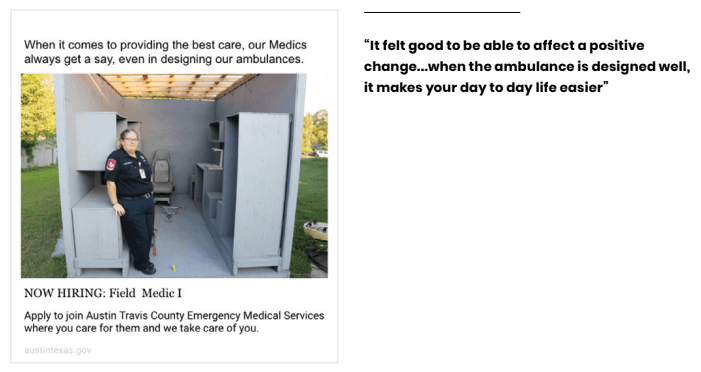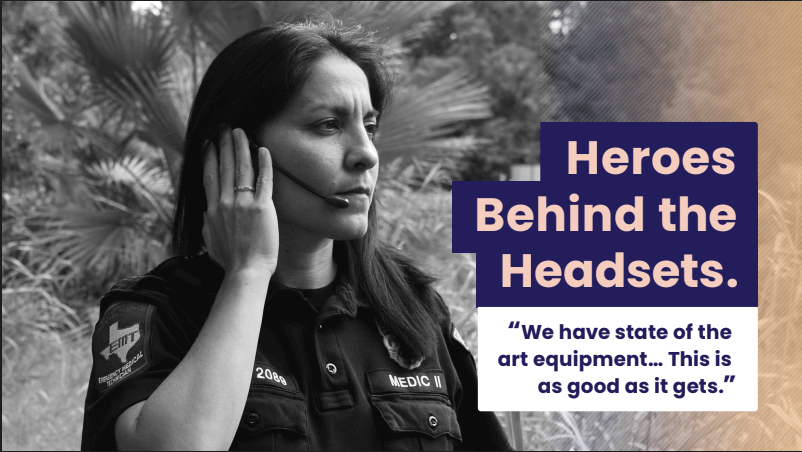Increasing Effectiveness of Medic Recruiting
Research, Facilitation, & Storytelling
“This is powerful. We will use these learnings to guide our future initiatives.”
Overview
Opportunity
Previous campaign
“How might Austin-Travis County Emergency Medical Services reach and attract more qualified medics?
Austin-Travis County Emergency Medical Services (ATCEMS) is a busy, demanding system for medics. In the past, there has been inconsistent and ineffective messaging to recruit medics who would excel in the system and stay with the organization long term.
ATCEMS is an outstanding EMS provider - both for the exceptional care they provide, industry leading innovations, and top quality work environment. But they weren’t telling that story, and their current messaging wasn’t spreading beyond their local network.
Outcomes
An image from our campaign
A marketing campaign and communications strategy that makes ATCEMS stand out from the competition and draw the top quality medics they need.
Guidelines and tools for continuing to create effective campaigns in the future.
Established baseline metrics and success metrics for future campaigns.
Impact
ATCEMS is now attracting higher quality medic candidates, leading to more new hires: 150% increase in qualified paramedic applicants.
New hires are reporting that the messaging is what attracted them.
Existing medic staff report that they feel more listened to and appreciated as a result of this project.
ATCEMS initiated another project to address an issue raised by our research, and in a separate project, utilized the human-centered design process based on what they learned from us.
Team
Me, user researcher and concept designer
Courtney Jacinic, content strategist and marketing expert
Hillary Berquist, ATCEMS partner and all-around doer
Michael Henderson, project manager
An outside design vendor, In-House International, for the visual assets
Case Study
We found ATCEMS was not differentiating themselves and was focusing recruiting efforts in less effective places
Discovery Research
We wanted to know, "Why is ATCEMS not attracting the recruits they need?" We worked with our clients to review their recruiting efforts (led by my content strategy teammate) and surveyed medics internally and from around the country to understand how they learn about new jobs (led by me.)
Finding: ATCEMS was not making themselves stand out
They were sharing generic hiring messages and typical narratives of EMS work - rather than speaking to what they can uniquely offer to medics.
ATCEMS recruiting Facebook post.
Finding: ATCEMS were focusing their efforts on less effective channels
Digital channels, like job listing sites, were the main way that medics look for jobs. Physical channels, like job fairs, were very low, yet the main strategy of our client.
We learned about the identity of ATCEMS
Shadowing, Contextual Interviews, and Synthesis Workshop
We wanted to learn, "What is unique about ATCEMS and how do we tell that story?" We shadowed medics to learn about what their days look like and gathered information and stories to define the narrative of the organization. Led by me, involving the whole team, in collaboration with our clients.
Some context - There are 2 categories of medics - “field medics” who work on the ambulances, and “communications (comm) medics” who work the phones in the 911 center.
Outcome: Narratives
A story of Field Medics: The Sweethearts of ATCEMS
“We get to be practitioners here, figure things out for ourselves.” - EMT
Imagine you’re sitting at your ambulance station and you get a call for an elderly woman who is woozy and disoriented. You drive your ambulance to her house, and after examining her, you discover that her blood pressure is low because she hasn’t eaten a proper meal. At your past job, you would have had to whisk her off to the ER no matter what so that your company could boost profits. But here, you’re urged to use your judgment to do what’s best for patients. So you fire up the stove and make her some eggs. Then you teach her some preventative measures, make her feel safe and secure, and head back to your station where you happily talk with your partner for half an hour until your next call. You're not here for just the emergencies; calls like this are why you love this career.
A story of Comm Medics: The Underdogs of ATCEMS
“I stay because I love what I do. Not everybody can do this job - take the pain, the screaming, then go home and be a normal human.” - Captain
Imagine you get to work with the first light. The moment you reach for a bite of breakfast, you get your first phone call. The person on the other end is screaming that their child is dying, and you snap into action. You calm them down enough to get the information you need to send an ambulance and to revive the child. Because you have top-notch training and technology, you can simultaneously type into your system while comforting the caller and coaching them through CPR. 6 long minutes later, the ambulance arrives, and you hang up the phone and try to collect your emotions as you think about your own children. No time for a break - next call comes minutes later.
Later you check with the medics who treated the child - it survived because you got their frantic parent to perform CPR just in time. You saved a family today; calls like this are why you love this career.
Outcome: Hypothesis Opportunities
We gathered a long list of qualities medics love about ATCEMS and hypothesized the top qualities to use in messaging:
Patient care over profits
Working for an organization with high standards
A meaningful career without a college degree
The ability to do advanced medical practices
Better pay and benefits
Outcome: Scope Change and Internal Culture Change Recommendation
We recommended an additional awareness campaign for comm medics. We unearthed an issue in the organizational identity - Comm medics didn't feel as understood, appreciated, or supported as field medics. I observed this as well when our clients would boast about programs for field medics but neglect to mention comm. I pulled together some comparative examples to present to our clients and they were shocked at the discrepancy in support.
Though our job was to market externally, we knew to create authentic messaging we had to improve the comm identity internally. We planned for the additional campaign to elevate their status in the organization. Additionally, our clients undertook an initiative to address these issues internally.
“I was able to call my commander for a reprieve and sleep for a few hours.”
“I can take a 10-minute break [but no one covers me and] I feel guilty leaving my team a person short.”
We determined that their organizational support would make ATCEMS stand out
Testing Our Hypotheses Through A National Survey
Our next question was: "Which qualities will resonate with our target recruits and make ATCEMS stand out from competitors?" I worked with our clients to identify their highest priority roles to target. We used the lists of qualities our medics love, and surveyed medics fitting those targets across the country, asking, "Imagine you are looking for a new job. Which of these would make you most interested in a potential position?" Led by me, involving the whole team, in collaboration with our clients.
“I feel like having mentorship and guidance is a huge part of making happy paramedics. I feel that EMS personnel is too often left alone to deal with the different stresses of the job.”
Finding: Correcting Hypotheses
To our surprise, the top qualities we hypothesized were not the biggest opportunities. There was one clear opportunity:
Organizational support, like respect from management, burn-out prevention, career growth, and counseling
We also identified a secondary opportunity, one we had overlooked:
Helping people
“Management is quick to throw [comm] under a bus but help others. They are also systematically trying to discredit us and the things we do. ”
Finding: Validating A Hypothesis
We validated that a separate awareness campaign for comm medics would resonate with target recruits, because we saw that other comm medics also felt undervalued, even more than those at ATCEMS. By seeing the company demonstrate appreciation for their role, they could see they would be valued at ATCEMS.
Outcome: Personas
“I use the personas to inform every new post I create.”
Based on the research, I created 5 personas to capture the different needs of our target recruits. I included the selling points on the personas so my team could easily connect the information with creating campaign ideas.
So we created campaigns that told the stories of organizational support and of communications medics
Co-creation Workshop and Concept Development
We started with a workshop to brainstorm campaign lines and visuals with our clients and then continued to iterate and narrow down to final concepts (co-led by me and my content strategy teammate). We created photograph concepts that were handed to a visual design firm, In-House International, to create final advertising assets.
Campaign 1: "You care for the community. We take care of you."
This campaign calls to the pride medics have in helping people, and communicates that ATCEMS can help them achieve their ambitions.


Campaign 2: "Heroes Behind the Headsets"
This campaign highlights the impact of the communication medic role and creates a meaningful visual for what communication medics do instead of depicting them behind a computer in a call center.


We provided training and created tools for ATCEMS to continue telling effective stories in the future
Documentation and Guidelines
Throughout the project, we incorporated our clients in co-creation workshops and educated them on human-centered design. We finished with a marketing campaign report that guides ATCEMS in utilizing our learnings and content for future marketing endeavors.
My content strategy teammate created editorial guidelines, checklists, and best practices, as well as directed the visual design firm in creating asset templates.
I added research assets like the personas and internal identity narratives and created guidelines to repeat our studies and workshops.
Our ATCEMS partner compiled our background and competitor research.
We established baseline metrics and means for ATCEMS to gather metrics going forward to measure the success of campaigns.
Impacts
As a result, Austin-Travis County Emergency Medical Services has had a 150% increase in qualified paramedic applicants; existing staff report that they feel more listened to and appreciated; the internal culture has improved around communications medics and their significance to the mission; and the organization is incorporating human-centered design practices into the way they do projects.






















